Ijraset Journal For Research in Applied Science and Engineering Technology
- Home / Ijraset
- On This Page
- Abstract
- Introduction
- Conclusion
- References
- Copyright
Medical Supplies Delivery Autonomous Drone with Security
Authors: Kanade Dnyaneshwar Gajanan, Aagam Kothari, Anubrat Chatterjee, Anurag Chatterjee, Swaroop Atreya
DOI Link: https://doi.org/10.22214/ijraset.2024.61335
Certificate: View Certificate
Abstract
Drones and UAVs have gained a lot of attention in the recent years. Being fast and efficient, they have the capability to carry out a multitude of tasks efficiently and quickly. One of the critical applications of drones is in the field of healthcare is the delivery of medical supplies. In case of severe natural calamities, only a drone is suitable for providing the basic essential supplies that can save the lives of constrained survivors. In rural and underdeveloped areas, a drone is ideal for delivery. The usage of a medical drone is not restricted as it can easily be used in day-to-day urban and sub-urban areas. It is an efficient method to deliver medicines and aid to patients and those in need. However, the security and authenticity of the medical supplies must also be preserved. This helps in maintaining the integrity of the healthcare system. The drone is equipped with an RFID Interrogator (Reader). The use of radio waves in Radio Frequency Identification (RFID), allows for the automatic detection and monitoring of tags. These tags act as ‘keys’ while the reader acts as a ‘lock’. The keys are made available to the customers, who are using this service. Integrating RFID into drone delivery systems enables authentication of medical supplies throughout the delivery process, minimizing the risk of theft, tampering and counterfeiting. A range of components have been used for this project as it combines the concepts from mechanical, electronics and computer engineering fields. Some key components are Arduino UNO, RFID, brushless DC motors, etc.
Introduction
I. INTRODUCTION
In an era where rapid and reliable access to medical supplies can be a matter of life and death, our innovative project harnesses the potential of automated drone technology to overcome the persistent challenges faced by conventional methods of transportation. Traditional medical supply delivery systems often grapple with traffic congestion, geographical barriers, and unforeseen delays, hindering the timely delivery of critical medications and supplies to those in need. Our project envisions a paradigm shift in the landscape of medicinal deliveries, striving to eliminate these obstacles through the deployment of cutting-edge automated drone technology. By doing so, we aim to revolutionize the efficiency and effectiveness of medical supply chains. Drones, equipped with state-of-the-art navigation systems, can navigate through complex terrains and congested urban areas, ensuring swift and reliable deliveries even in the face of logistical challenges. The primary objectives of our project are to significantly minimize delivery timeframes, thereby ensuring that medical supplies reach their destination in the shortest possible time. This reduction in delivery time not only addresses the urgency associated with medical needs but also plays a crucial role in mitigating the risk of stockouts, ensuring a consistent and reliable supply of essential medications. Through these advancements, our project aspires to make a tangible impact on healthcare outcomes, contributing to the enhancement of patient care and, ultimately, saving lives. By leveraging automated drone technology, we are not just revolutionizing the way medicinal deliveries are conducted; we are pioneering a new era of efficiency, accessibility, and reliability in the realm of healthcare logistics.
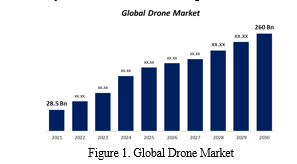
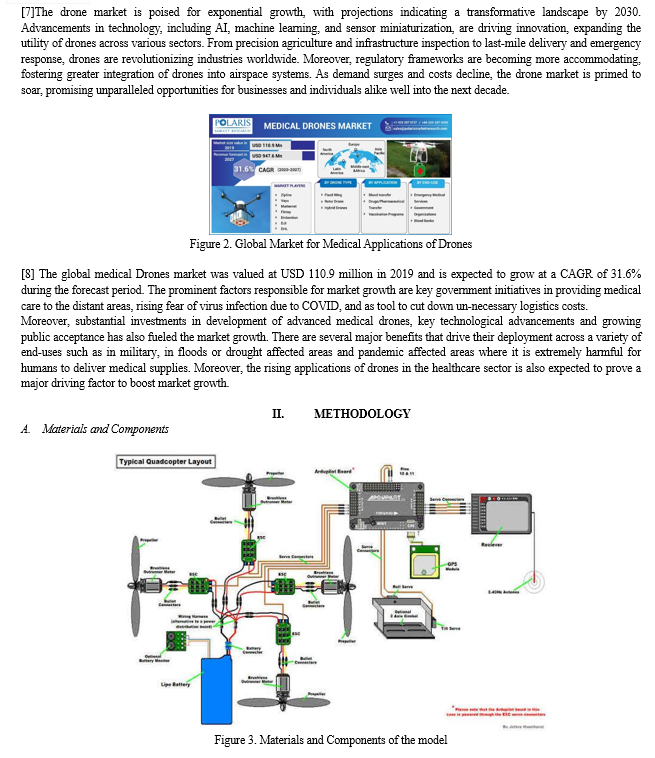
- Brushless DC Motors: As the designed drone was a quadcopter, four brushless direct current motors were used for this purpose. The motor constant was chosen 920 kV (capable of generating 920 rotations per minute for every volt provided). These motors can easily provide the lift for the drone which a brushed DC motor is incapable of doing.
- Electronic Speed Controller (ESC): Every motor requires an ESC. It is a crucial component that control and regulates the speed of the motor by adjusting the power supplied to it. Four ESCs, each rated 30 A were used. It receives throttle commands from the pilot via the flight controller and adjusts the power supplied to the motors accordingly, controlling the rotational speed of the propellers.
- MPU 6050: It is a popular Inertial Measurement Unit (IMU) that provides information about the orientation and acceleration of the drone. It consists of inbuilt 3-axis gyroscope, 3-axis accelerometer, temperature sensor and digital motion processor. It using I2C protocol for communication.
- LiPo Battery (11.1 V): A LiPo (Lithium Polymer) battery is a type of rechargeable battery commonly used in various electronic devices. It has a fairly high discharge rate and has to be charged regularly.
- The F450 Frame: It is a popular choice in the world of multirotor drones, known for its versatility and durability. With a diameter of 50cm, this plastic frame provides a sturdy foundation for building unmanned aerial vehicles (UAVs) for various applications. Its 450mm motor-to-motor distance strikes a balance between agility and stability, making it suitable for both beginners and experienced drone enthusiasts.
- The Ubox Neo-7M GPS Module: is a compact and powerful navigation solution with a built-in compass, enhancing its capabilities for accurate and reliable life tracking applications. The Neo-7M, known for its high precision and low power consumption, seamlessly integrates GPS and GLONASS satellite systems, ensuring robust global positioning. The inclusion of an in-built compass further improves orientation accuracy, crucial for real-time tracking in dynamic environments. Whether used for fitness monitoring, outdoor activities, or location-based services, the Ubox Neo-7M's combination of GPS and compass functionality provides a comprehensive solution for users seeking precise and continuous tracking experiences with minimal energy
- RFID Interrogator-Identifier Pair: A standard RFID reader-tag pair has been used to make the door locking system.
- Servo Motor: It was also a part of the door-locking mechanism. If the RFID reader receives the signal from an authorised tag, the servo motor would be activated and it would open the door of the container in which the medicines are stored. This allows only the authorised individual to access the contents.
- Container: A container that would carry the patient’s medicines was attached below the drone. The container has a window on which the door-locking system was implemented. The box was 3D printed and internally divided into four compartments.
- Pixhawk: Is a highly versatile open-source autopilot system designed for unmanned aerial vehicles (UAVs). Developed by the Pixhawk open hardware project, it serves as the brain of drones, providing advanced flight control capabilities. The Pixhawk flight controller supports a wide range of vehicles, from quadcopters and hexacopters to planes and ground rovers. Its modular design allows for flexibility and customization, accommodating various sensors, GPS modules, and communication peripherals. With a robust ecosystem of compatible software like ArduPilot, Pixhawk enables autonomous flight, waypoint navigation, and mission planning. It has become a standard in the drone industry, valued for its reliability, extensive community support, and continuous development, making it a popular choice for hobbyists and professionals alike seeking a powerful and adaptable autopilot solution.
- Apache Net Beans: Is an open-source integrated development environment (IDE) used for Java, HTML, PHP, and other programming languages. It offers a feature-rich environment for software development, with tools like code editors, debugger, profiler, and GUI builder. NetBeans supports modular and extensible architecture, allowing developers to customize their workflow. It includes seamless integration with Apache Maven and version control systems like Git. With a user-friendly interface, it facilitates rapid application development and supports various frameworks. As part of the Apache Software Foundation, NetBeans is actively maintained, providing a free and powerful IDE for diverse software development projects across different platforms.
Mission Planner is a comprehensive open-source ground control station software primarily designed for unmanned aerial vehicles (UAVs) powered by the ArduPilot autopilot system. It allows users to plan, execute, and monitor autonomous missions for drones, offering a user-friendly interface for mission setup, waypoint navigation, and real-time telemetry. Mission Planner supports various flight modes, parameters adjustment, and data logging. Its advanced features include geofencing, camera control, and 3D flight visualization. Compatible with Windows, Linux, and Mac, Mission Planner is a vital tool for drone enthusiasts, researchers, and professionals, providing a robust platform for efficient and customizable UAV mission planning and management.
B. Working
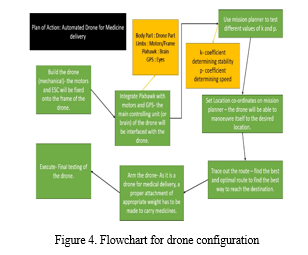
In a hypothetical urban setting, the deployment of automated drones for urgent medical deliveries presents a transformative solution to logistical challenges faced by individuals living in densely populated areas. Consider a scenario where a patient, residing three kilometers away from the nearest healthcare facility, urgently requires medication but finds it difficult to obtain due to the congested nature of their surroundings. This situation epitomizes the growing demand for efficient and timely delivery services, especially in urban environments where traditional modes of transportation are hindered by traffic congestion and accessibility issues.
Enter the automated medical delivery drone – a cutting-edge solution designed to navigate urban landscapes swiftly and seamlessly, circumventing the limitations of ground transportation. Equipped with state-of-the-art BLDC (Brushless DC) motors meticulously engineered to generate sufficient lift, these drones effortlessly ascend into the sky, unimpeded by terrestrial obstacles. The aerodynamic design and precise motor control enable the drone to achieve stable flight and maneuverability, essential for navigating complex urban environments.
At the heart of the drone's operation lies a sophisticated control system, comprising Electronic Speed Controllers (ESCs) that regulate the power supplied to each motor. Through precise adjustments in motor speed, the drone can execute intricate movements such as forward/backward translation and right/left turns. This dynamic control mechanism allows the drone to navigate through narrow alleyways and congested streets with unparalleled agility, bypassing the gridlock that often plagues ground-based transportation.
Furthermore, the integration of advanced sensor technology enhances the drone's navigational capabilities, ensuring safe and reliable operation in diverse environmental conditions. The inclusion of an MPU 6050 gyroscope enables the drone to maintain stable flight and hover accurately, even in the presence of external disturbances. This level of autonomy and stability is crucial for executing precise delivery maneuvers and ensuring the safety of both the drone and its payload.
In the context of medical deliveries, the automated drone serves as a lifeline for individuals in need of urgent medication or supplies. Once a delivery request is received from a healthcare facility, the drone is dispatched with the necessary items securely stored in its cargo bay. The payload is sealed using an RFID (Radio Frequency Identification) mechanism, ensuring tamper-proof security during transit. This seamless integration of technology streamlines the delivery process, minimizing the risk of errors or delays associated with traditional delivery methods.
Upon reaching the designated drop location, the drone engages a 'position hold' command, leveraging its GPS (Global Positioning System) module to hover precisely above the target area. This precise control mechanism facilitates the safe and accurate delivery of the payload, ensuring that the recipient receives their medication without delay. Access to the delivered supplies is granted via an authorized RFID key, which activates a servo motor to unlock the cargo bay upon authentication.
Once the delivery is complete, the drone autonomously navigates back to its point of origin, retracing its flight path with precision and efficiency. The entire delivery process is seamlessly monitored and controlled through an intuitive Mission Planner Interface, which provides real-time telemetry data and tracking information. This comprehensive oversight ensures the safety and reliability of the delivery operation, empowering healthcare providers to meet the needs of their patients effectively.
III. TESTS AND RESULTS
A test run was conducted to test the drone in a real-life application. The aim was to calculate experimentally the altitude of flight and distance of flight. The payload capacity was calculated in the following manner:
Drone Weight: 1.5 kg
Battery Weight: 150 g
Equipment Weight: 70 g
Total weight: 1.72 kg
RPM = Motor Constant x Volts Provided x Motor quantity
RPM = 920 kV x 11.1 V x 4
RPM = 10212 x 4
RPM = 40848 rpm
Thrust = ~6.66 kg
Power to Weight ratio: 3:1 (standard)
Number of motors: 4
Total thrust produced: 6.66 kg
Thrust per motor: 1.665 kg
Payload = Total thrust – Total weight
Payload = 6.66 –
Payload= 4.92 kg
According to our calculations, it is evident that the drone can carry at least 4.44 kg. In a real-life application, the limit will be lower considering motor efficiency, temperature, altitude and wind conditions. Medicines are small items and thus has very less weight. A standard medicine delivery does not weigh more than half a kilogram. The drone can carry payload worth eight times a standard delivery. By keeping these factors in mind, a container box was made using a 3D printer. Using a 3D printer allows us to give the container a shape and size which helps us reduce the drag that the drone will face while mid-air.
For the test flight, a random prescription of a cough-cold patient was acquired and the medicines of that prescription was considered for the testing payload. The payload was the following:
Tablets Pan 40 (3) – 45 grams
Tablets Meftal Forte (6) – 70 grams
Tablets montekLC (5) – 65 grams
Bottle of Honitus Cough Syrup – 100 grams
Total weight – 280 grams = 0.28 kg
The college campus was chosen as the launch point. The drop point was also within the college campus. The FS-CT6B receiver was connected to the flight controller (MPU 6050) which was present on the drone. The transmitter remained at the ground control station. The drone was able to take-off successfully and hover in the air without any visible difficulties. The altitude was kept low initially, around 9 feet from ground level and the height was slowly increased. As the altitude was increased, the pitching movement of the drone allowed it to move forward. These controls were all facilitated through the Pixhawk Flight controller. The flight distance was 236 metres (lengthwise measurement of the college grounds). Halfway during its journey, the drone was able to reach a maximum height of 34.7 feet. It could safely manoeuvre its way to the destination. One of the members was present at the drop location with the RFID key. The drone was set into ‘positional hold’ state which allowed it to hover at the given position without landing. To test the authenticity of the security system, the member was provided with two identical RFID keys. Only one of them was authorised to open the RFID locking system. The wrong key was used several times but did not work while the correct key opened it easily. The door locking system was secured and protected thus it was not possible to break or tamper. There was a one-minute timer delay after which the door would lock itself after unlocking. When the simulated delivery process was complete, the drone returned to the ground control station using the same route. The total distance of flight was approximately 490 metres and time of flight was exactly two minutes and seven seconds. If the drone travelled only from one point to other and back, without stopping, the speed would be approximately 7.2 m/s.
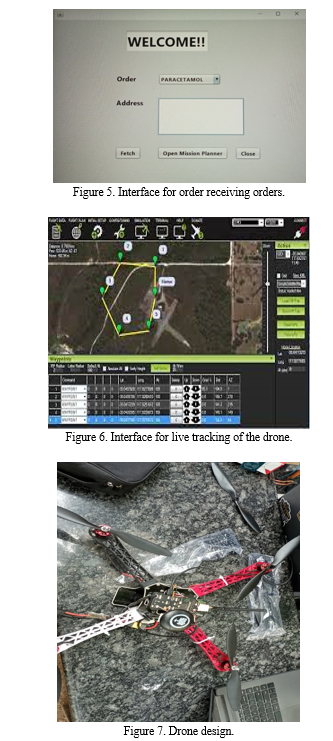
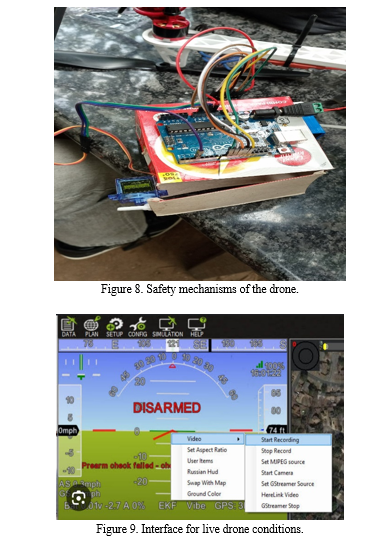
IV. INFERENCES
The following inferences were drawn from the test flight: -
- The drone was easily able to carry a payload of 0.28 kg and reach the destination. The motors and drone frame could support the payload.
- There were no visible problems due to weather conditions like strong winds during the flight test.
- The drone is safe from thieves when it is in the air. Even during the ‘hover’ phase of the delivery process, only authorized persons may be able to access the contents.
- The RFID security system proved to be the right choice at it is a simple and easy way to construct a reliable door locking system.
- A separate altitude test was conducted to test the limits to which the drone could rise upwards. No payload was attached for this test. The limit was approximately 45 feet after which the drone would not rise higher. At higher altitudes, wind becomes a greater risk.
- The MPU 6050 was a reliable flight controller for this project.
V. DEVELOPMENT
UAV delivery services exist on a very small scale all around the world. Most of the times, the delivery processes that these UAVs adopt is simply dangerous and still does not solve the major issue of security.
A renowned facility in Rwanda has taken a similar approach to medical supplies and vaccine delivery in rural areas. The UAV designed by them is launched into the air by a launching mechanism which gives it a very high launch speed. It can then be controlled like an RC plane to navigate and deliver the medical package. However, the delivery approach they have taken is completely different. When the drone is flying above the delivery location, the medical package is dropped to the ground by the means of a parachute. This method can not only damage the contents of the package but also injure someone passing by. Also, if the drop is not accurate, the dropped package might get stolen or lost before the patient can recover it. The launching facility itself needs a lot of capital and investment for initial setup. This kind of a service can be provided only to big hospitals and healthcare facilities but it becomes a problem for doorstep delivery. A similar approach was taken by the Indian Government in Arunachal Pradesh but it faces the same drawbacks as it did in Rwanda. The drone designed by us attempts to solve some of these issues. Instead of air-dropping the medical items, the drone lowers itself to the patient’s location. The security is also rigid which ensures that theft is kept to a minimum. The RFID based security system is the best way to ensure safe doorstep delivery of essential supplies. The designed drone is an example of VTOL (Vertical Take-off and Landing). It means that it requires no launch facility and is able to take-off and land without a runway. Although it sacrifices delivery speed, it considerably reduces installation costs while still being much more economically feasible and efficient as compared to a land vehicle.
VI. FUTURE SCOPE
A medical delivery drone can bring about major changes in the medical field. The designed drone was a prototype that can be greatly enhanced in the future.
- Although Plastic is a sturdy and lightweight solution, it pales in comparison to modern materials like carbon fibre. Using carbon fibre frame would not only greatly reduce drone weight but also enhance stability and rigidity.
- The designed drone is not automated. It ultimately requires a human to control and navigate it to its destination. An autopilot system could be used for example, ArduPilot or Pixhawk. It would eliminate the requirement of a human being.
- By interfacing the Arduino with enhanced barometers, we can ensure better stability and altitude features. Addition of a magnetometer would greatly enhance navigation. A magnetometer acts as compass that helps in navigation.
- Better ESCs and more powerful motors can significantly enhance drone speed. It cannot rival the speed of a drone that is launched into the air but it significantly reduces the time required for delivery.
- Better motors would also help in reducing the noise caused by the drone. Additionally, damping materials can be used to reduce sound.
VII. ACKNOWLEDGEMENT
We would like to thank our college, Vishwakarma Institute of Technology, Pune for giving us the opportunity to study and build a drone. We would also thank the professors of Electronics department for helping us understand each component and helping us integrate them into our project.
Conclusion
In conclusion, the integration of RFID technology into medical supplies delivery drones brings significant benefits to the healthcare sector. By combining the capabilities of drones with RFID security features, healthcare providers can ensure the safe and efficient delivery of essential medical supplies to remote or inaccessible areas. RFID technology enables authentication, verification, and traceability of medical supplies, reducing the risk of tampering or unauthorized access. RFID allows real-time tracking and traceability of medical supplies. It can overcome geographical barriers and traffic congestion, enabling faster and more efficient delivery. This is particularly valuable in emergency situations or when reaching remote areas with limited infrastructure. Overall, the integration of RFID technology enhances the security, traceability, and efficiency of medical supplies delivery drones.
References
[1] Geoffrey Ling1,2 and Nicole Draghic2 “Aerial drones for blood delivery” https://rdcr.org/wp-content/uploads/2020/02/Ling_et_al-2019-Transfusion.pdf [2] Evan Ackerman; Eliza Strickland \\\"Medical delivery drones take flight in East Africa. [3] Evan Ackerman; Michael Koziol \\\"The blood is here: Zipline\\\'s medical delivery drones are changing the game in Rwanda\\\" https://ieeexplore.ieee.org/abstract/document/8701196 [4] Albert Apotele Nyaaba a, Matthew Ayamga \\\"Intricacies of medical drones in healthcare delivery: Implications for Africa\\\" https://www.sciencedirect.com/science/article/pii/S0160791X21000993 [5] Manohari Balasingam \\\"Drones in medicine—The rise of the machines\\\" https://onlinelibrary.wiley.com/doi/pdf/10.1111/ijcp.12989 [6] Scott, Judy Scott, Carlton \\\"Drone Delivery Models for Healthcare\\\" https://scholarspace.manoa.hawaii.edu/items/947f05d9-71f2-467a-8291-084642e402ad [7] https://www.sphericalinsights.com/reports/drone-market [8] https://www.polarismarketresearch.com/industry-analysis/medical-drones-market [9] L. Faramondi et al., \\\"Use of Drone to Improve Healthcare Efficiency and Sustainability,\\\" 2020 43rd International Convention on Information, Communication and Electronic Technology (MIPRO), Opatija, Croatia, 2020, pp. 1783-1788, doi: 10.23919/MIPRO48935.2020.9245247. keywords: {Hospitals;Transportation;Biology;Automobiles;Sustainable development;Drones;Biological materials}, [10] Krey, M., & Seiler, R. (2019). Usage and acceptance of drone technology in healthcare : exploring patients and physicians perspective [Conference paper]. Proceedings of the 52nd Hawaii International Conference on System Sciences, 4135–4144. https://doi.org/10.21256/zhaw-3372 [11] Zailani MAH, Sabudin RZAR, Rahman RA, Saiboon IM, Ismail A, Mahdy ZA. Drone for medical products transportation in maternal healthcare: A systematic review and framework for future research. Medicine (Baltimore). 2020 Sep 4;99(36):e21967. doi: 10.1097/MD.0000000000021967. PMID: 32899033; PMCID: PMC7478386. [12] INTERNATIONAL JOURNAL OF SCIENTIFIC & TECHNOLOGY RESEARCH VOLUME 9, ISSUE 01, JANUARY 2020 ISSN 2277-8616 2676 IJSTR©2020 www.ijstr.org Design And Development Of Drone For Healthcare N. Nithyavathy, S. Pavithra, M. Naveen, B. Logesh, T. James [13] https://ieeexplore.ieee.org/abstract/document/8241731
Copyright
Copyright © 2024 Kanade Dnyaneshwar Gajanan, Aagam Kothari, Anubrat Chatterjee, Anurag Chatterjee, Swaroop Atreya. This is an open access article distributed under the Creative Commons Attribution License, which permits unrestricted use, distribution, and reproduction in any medium, provided the original work is properly cited.

Download Paper
Paper Id : IJRASET61335
Publish Date : 2024-04-30
ISSN : 2321-9653
Publisher Name : IJRASET
DOI Link : Click Here
 Submit Paper Online
Submit Paper Online

